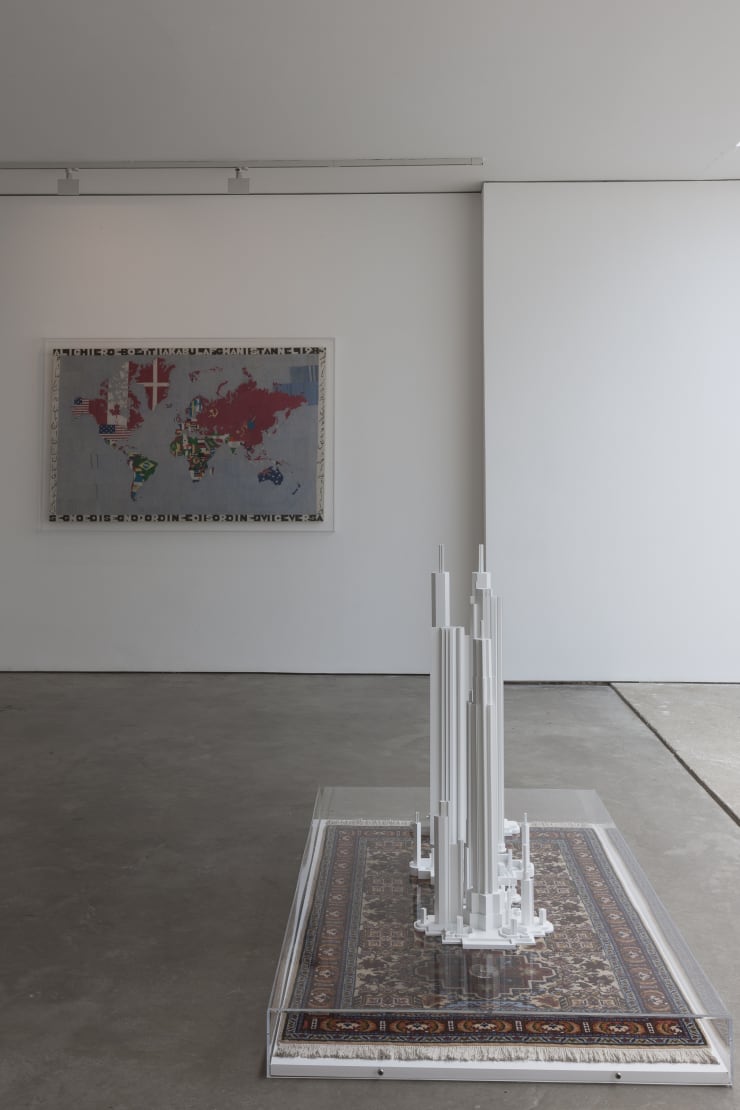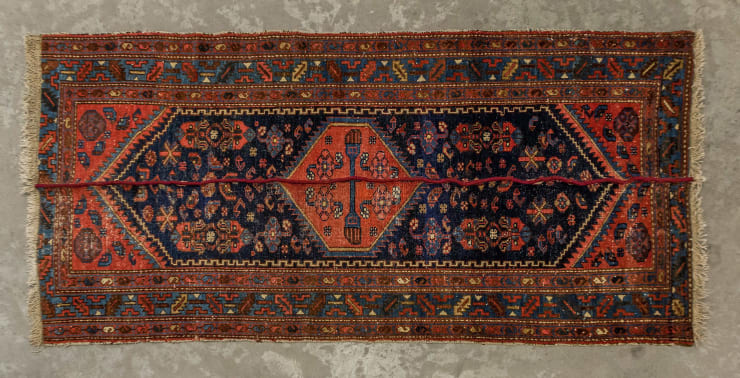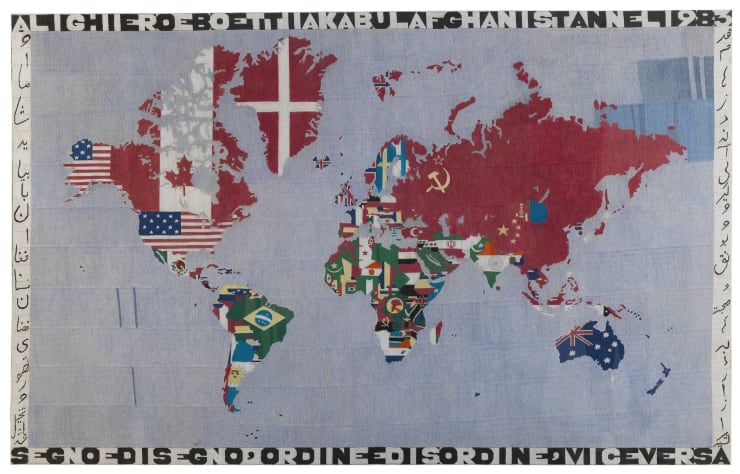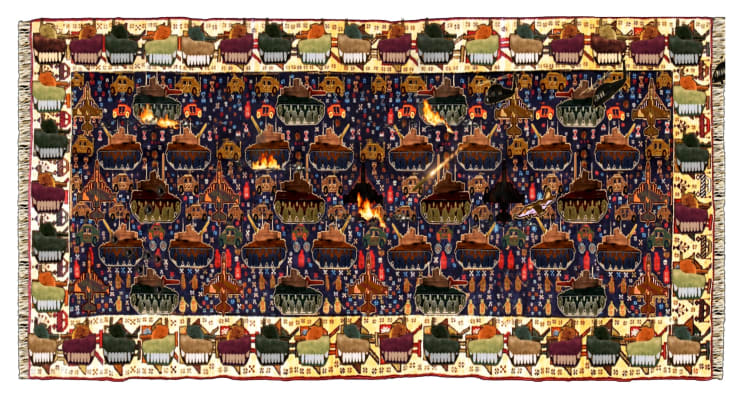Metatextile: Ruptured narratives, exchanged values
Private View | Thursday 9 June, 6-8pm
Pio Abad
Nazgol Ansarinia
Alighiero Boetti
Jeremy Deller / Ed Hall
Leah Dixon
Adrian Esparza
Babak Golkar
Timur Novikov
Liubov Popova
Slavs and Tatars
Nevet Yitzhak
Edel Assanti is pleased to present Metatextile, an exhibition drawing together historic and contemporary works united in their employment of fabric and textiles as a means of challenging prevalent social hierarchies, historical narratives and perceived value systems.
The exhibition aims to highlight the consistent artistic strategies surrounding the use of textiles as an avant-garde medium. These include the outsourcing of labour as a method of retaining proximity to specific traditions or communities; the assimilation of culturally-specific aesthetic languages as a critique of the orders of value, history or identity that they evoke; the collapsing of public and private domains to draw attention to the relationship between citizen and state, ideology and individual, and domestic versus communal.
Textiles maintain a constant presence across human history and geography, employed not only for functional ends, but also as agents of cultural interaction. The value in which they are esteemed varies across cultures and contexts, ranging from utilitarian to artisanal and even reverential status. Beyond their immediate practical applications, textiles have been an important means of portraying and disseminating historical narratives, and equally as an abstract record of collective memory in folk communities. More recently, the medium has emerged as an apparatus in international avant-garde artistic practices that share a remarkable conceptual proximity.
Metatextile includes one of the earliest examples of the use of textiles within a 20th century avant-garde context, in the form of Constructivist artist Liubov Popova’s hammer and sickle fabric designs. It was the accessibility of the material that attracted Popova, who claimed ‘no single artistic success gave me such profound satisfaction as the sight of a peasant woman buying a piece of my fabric for a dress.’ The proximity of the medium to a broader public context equally informs its use by many of the artists who followed Popova, including Pio Abad, Nazgol Ansarinia and Adrian Esparza. The exhibition includes the loan of the seminal work Apollo Trampling on the Black Square from the Estate of Timur Novikov – the artwork that launched the post-communist New Academy movement in St Petersburg. The work encapsulates the conflict between the spiritual essence of art (the god Apollo) and the quintessence of the revolutionary avant-garde (Malevich’s Black Square).
The exhibition also includes a Mappa by Alighiero Boetti, an early example of the practice of the artist removing himself from the production process within the medium. Boetti left many creative choices to the artisans in Pakistan and Afghanistan whom he commissioned to make his Mappa series, which impacted on both their designs and content. The series’ cataloguing of a changing global geopolitical landscape from 1971 to 1994 forms a cradle for many of the themes of national and generational identity that the exhibition seeks to explore in its core focus on artists working with textiles today.
Boetti’s procedure is echoed in the work of Maja Bajevic, Jeremy Deller and Slavs and Tatars, who respectively commissioned artisanal workshops to fabricate their works, each with distinct motives relating to the heritage or origins of the workers they selected. Bajevic’s tapestries are drawn from her series included in All the World’s Futures at the 56th Venice Biennale, in which traditional Bosnian embroidery is used to replicate the fluctuations of stock market indexes around the world. The works question what kind of value we place on traditional craftsmanship in the face of the relentless homogenisation caused by globalisation. The exhibition also includes especially commissioned banners made by Jeremy Deller in collaboration with British sign-maker Ed Hall, referencing the alternative history documented within Hall’s protest banners over the past four decades.
The traditional significance of textiles makes them an ideal site for interrogation of the defining events of our era within a broad historical and cultural context. As demonstrated in Metatextile, it seems unsurprising that artists have appropriated textiles and the heritage they invoke as a means of defining a generation’s identity, and challenging overarching narratives and systems of communication that govern contemporary society.
The exhibition is accompanied by a publication featuring an essay by Anne Roehl of Kunsthistorisches Institut, Zurich.
-
 Alighiero Boetti, Mappa, 1983
Alighiero Boetti, Mappa, 1983 -
 Nevet Yitzhak, War Rug #3, 2014
Nevet Yitzhak, War Rug #3, 2014 -
 Timur Novikov, Apollo Trampling on the Red Square, 1991
Timur Novikov, Apollo Trampling on the Red Square, 1991 -
 Slavs and Tatars, Simorgh Solidarność, 2011
Slavs and Tatars, Simorgh Solidarność, 2011 -
 Slavs and Tatars, Man of Iran, 2011
Slavs and Tatars, Man of Iran, 2011 -
 Adrian Esparza, Glass House 3, 2014
Adrian Esparza, Glass House 3, 2014 -
 Liubov Popova, Textile design, 1923-1924
Liubov Popova, Textile design, 1923-1924 -
 Nazgol Ansarinia, Mendings Carpet, 2010
Nazgol Ansarinia, Mendings Carpet, 2010 -
 Babak Golkar, Negotiating Space no. 10, 2009 - 2011
Babak Golkar, Negotiating Space no. 10, 2009 - 2011 -
 Leah Dixon, Under a Watchful Eye I, 2016
Leah Dixon, Under a Watchful Eye I, 2016 -
 Leah Dixon, Under a Watchful Eye II, 2016
Leah Dixon, Under a Watchful Eye II, 2016 -
 Pio Abad, Every Tool is a Weapon if you Hold it Right XXXVI, 2016
Pio Abad, Every Tool is a Weapon if you Hold it Right XXXVI, 2016 -
 Pio Abad, Every Tool is a Weapon if you Hold it Right XXXVII, 2016
Pio Abad, Every Tool is a Weapon if you Hold it Right XXXVII, 2016 -
 Jeremy Deller, A double basement being built in Hampstead, 2013
Jeremy Deller, A double basement being built in Hampstead, 2013
-

'Metatextile' in Whitehot Magazine
'The New Wave of Textile Art: A Globalized Web at Edel Assanti, London' by Gracie Linden 19 July 201619 September 2016 Within the art world, textiles have never been seen as especially sexy. Rarely do headlines flash with record-breaking sales of Renaissance tapestries....Read more -

'Metatextile' in Sotheby's Cultural Crossroads blog
'Fashion, Design, Crafts and Visual Arts Unite in London' by Roxane Zand 28 June 201628 June 2016 London never sleeps when it comes to art from the Middle East. There is always one show or another, offering an introduction...Read more















